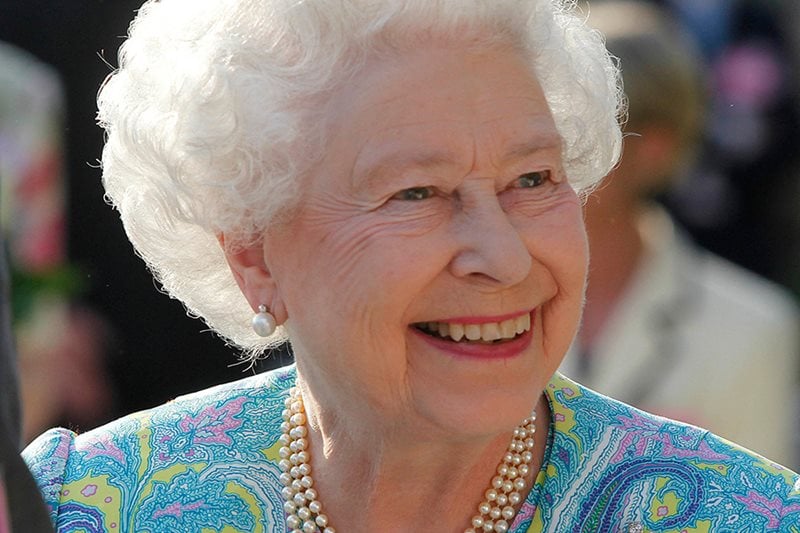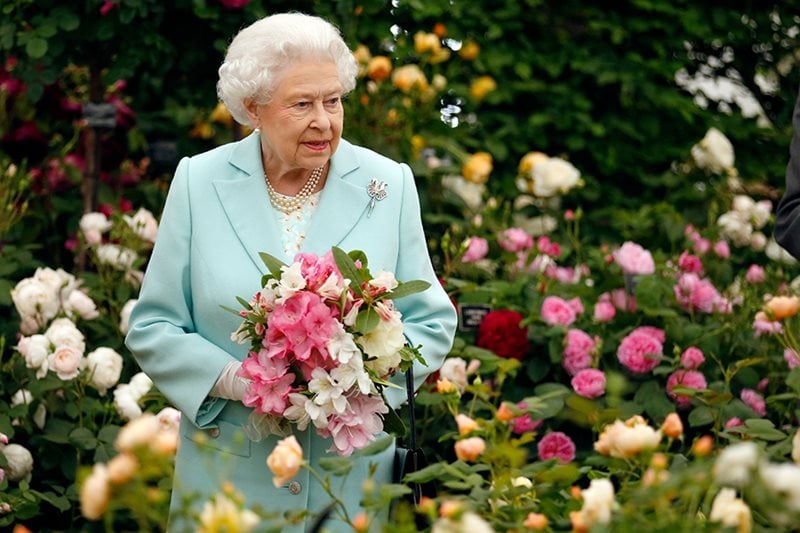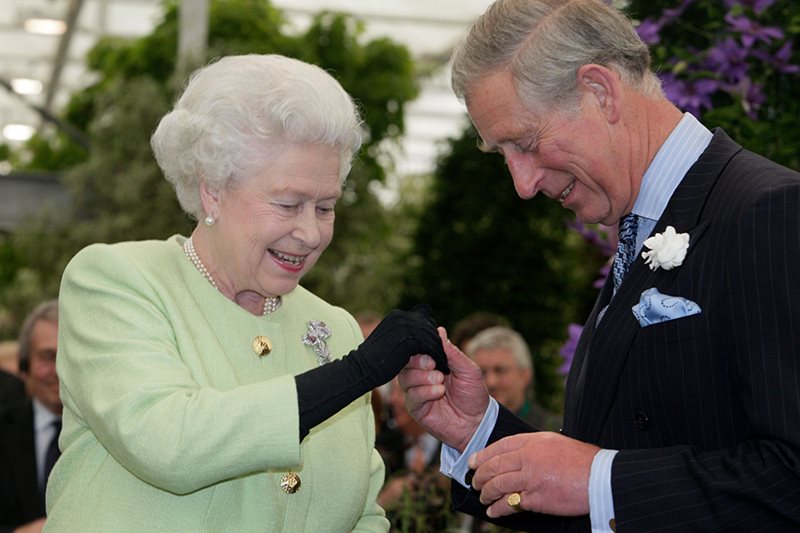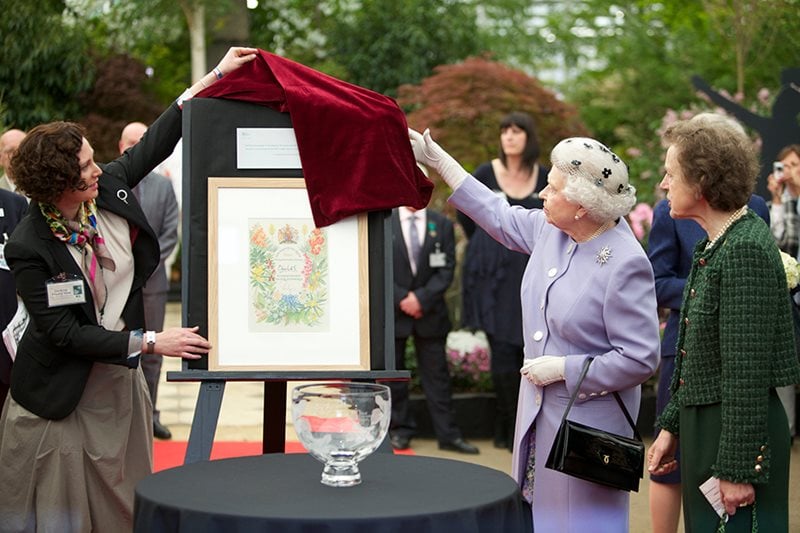 It is with deep sadness and profound respect that we mark the passing of Her Majesty Queen Elizabeth II, Patron of the Royal Horticultural Society.
It is with deep sadness and profound respect that we mark the passing of Her Majesty Queen Elizabeth II, Patron of the Royal Horticultural Society.
From an early age, Her Majesty understood the value of gardening and gardens, growing up as she did at Royal Lodge, Windsor, where her parents, King George VI and Queen Elizabeth, concerned themselves closely with the layout and planting of a woodland garden.
At the age of six, Princess Elizabeth was given a miniature cottage by the people of Wales; this was placed in the garden at Royal Lodge, and had its own little formal garden. In 1940, she was photographed, with her younger sister, Princess Margaret Rose, in the grounds of Windsor Castle to provide publicity for the ‘Dig for Victory’ campaign.
Her Majesty became the Patron of the Society in 1952, on the death of her father, carrying on the dynastic association with the RHS which had begun in Victorian times. She performed the role alongside HM Queen Elizabeth The Queen Mother, who was Patron of the RHS for 65 years, until her death in 2002. The RHS Council minutes of 23 June 1952 report that the President had received a letter from Sir Ulick Alexander, Keeper of the Privy Purse, informing him that Her Majesty The Queen was graciously pleased to grant her patronage to the RHS.
 Since Queen Mary’s time, the absolute highlight in the Society’s gardening year has been the Royal visit to the RHS Chelsea Flower Show each May. The first Royal visit to an RHS show was in 1890. From her teens, Her Majesty regularly accompanied her parents to ‘Chelsea’ and brought to it an interest and an appreciation which was highly valued by staff and exhibitors, as well as by the millions who watched on television. The profile of the show, as a fixed and important annual event in the nation’s life, was in part due to her continued support.
Since Queen Mary’s time, the absolute highlight in the Society’s gardening year has been the Royal visit to the RHS Chelsea Flower Show each May. The first Royal visit to an RHS show was in 1890. From her teens, Her Majesty regularly accompanied her parents to ‘Chelsea’ and brought to it an interest and an appreciation which was highly valued by staff and exhibitors, as well as by the millions who watched on television. The profile of the show, as a fixed and important annual event in the nation’s life, was in part due to her continued support.
The Queen would arrive at the Bull Ring on the Embankment on the Monday afternoon, to be greeted by the RHS President, who would escort her round the show, introducing her to exhibitors and Society staff on the way. Past Presidents remember these as delightful occasions, as informal as was possible in the circumstances, and all have commented on how knowledgeable and interested she was, and how the schedule often overran, despite the best efforts of her courtiers to keep the visit on track. She was fascinated by exhibits of flowers, especially roses, and those from tropical and subtropical Commonwealth countries, of which she was the Head of State.
Peter Harkness of Harkness Roses, Hertfordshire, remembers how, in 1986, he shared a ‘natural conversation’ with Her Majesty at RHS Chelsea. Knowing that she was shortly to visit Kunming in Yunnan province on an official visit to China, he was emboldened to ask whether she would plant a Rosa VOLUNTEER (‘Harquaker’), named in honour of the Voluntary Services Overseas, at the VSO station there. He later discovered that she had indeed taken the trouble to enquire whether this was possible as part of the itinerary, and had duly planted a rose in Kunming.
 During the 2009 flower show, The Queen presented HRH Prince Charles with the RHS Victoria Medal of Honour (VMH) – the Society’s most prestigious award – a tribute to his deep interest and expertise in horticulture.
During the 2009 flower show, The Queen presented HRH Prince Charles with the RHS Victoria Medal of Honour (VMH) – the Society’s most prestigious award – a tribute to his deep interest and expertise in horticulture.
Her Majesty’s patronage of the Society also led to visits to RHS Garden Wisley, Surrey, firstly in May 1978 when, accompanied by the late HRH Duke of Edinburgh, Prince Philip, she planted a Fagus sylvatica ‘Dawyck Purple’ AGM in the Jubilee Arboretum and, more recently, in June 2007, to open The Glasshouse built to celebrate the bicentenary of the RHS. During this visit she also presented the RHS VMH to three recipients.
Although not a ‘hands-on’ gardener, Her Majesty understood the importance of gardening to national life and took a lively interest in the gardens of her Royal residences. There can be no doubt that The Queen and Prince Philip enjoyed the peace and privacy of their gardens at Sandringham in Norfolk, Balmoral in Aberdeenshire, and at Buckingham Palace in London, but they also valued Buckingham Palace and the Palace of Holyroodhouse as venues for large-scale summer garden parties.
It is said that no one knew the gardens of Buckingham Palace better than she. Head Gardener, Mark Lane, would take her a posy of seasonal flowers every Monday morning when she was in residence. Changes and improvements to the gardens were the subject of discussions between Her Majesty and a succession of head gardeners but sadly, from time to time during her reign, she was forced to instigate rationalisation of the maintenance of the Royal gardens. In this regard, she was no different from any other owner of a stately home in the years since the Second World War.
By the 21st century, Buckingham Palace, which boasts the largest and most biodiverse private garden in the capital, was home to more than 350 types of wildflowers and 150 mature trees. These include the National Plant Collection of Morus (mulberry trees), which grow in the gardens both of Buckingham Palace and Kensington Palace. Eco-friendly mowing regimes were also introduced.
In 2002, at Windsor Castle, a new Jubilee Garden was commissioned from Tom Stuart-Smith, the first new garden to be made there for many years. Shortly before her 90th birthday in 2016, The Queen’s cousin, Lady Elizabeth Shakerley conceived a plan to make a Birthday Garden at Frogmore House in Windsor Home Park, which has always been a private retreat for the Royal Family.
Emboldened by the enthusiastic and knowledgeable response from Her Majesty, Lady Elizabeth summoned up support from family and friends, and called in Hillier Nurseries and Landscapes, Hampshire, to advise (along with the newly appointed Keeper of the Gardens, John Anderson) and provide most of the plants. The Birthday Garden was planted in the autumn of 2016 and spring of 2017, with a choice and varied mixture of trees, shrubs (many of them ericaceous) as well as roses. The Queen was enduringly engaged with the garden’s development, and held a party in Claridges Hotel, London, that summer to thank everyone who had helped to fund, or work on, the Birthday Garden project.
 To commemorate The Queen’s Diamond Jubilee in 2012, both Her Majesty and Prince Philip signed a Royal Autograph, painted on vellum and held in the RHS Lindley Library. The border of the Royal Autograph is decorated with botanical paintings of plants from the Commonwealth and was unveiled by Her Majesty at the 2012 RHS Chelsea Flower Show. This is the second Royal Autograph from The Queen. Her first, signed just with her name alone, marked the Coronation in 1952 and is decorated with pale pink dog roses and purple thistles.
To commemorate The Queen’s Diamond Jubilee in 2012, both Her Majesty and Prince Philip signed a Royal Autograph, painted on vellum and held in the RHS Lindley Library. The border of the Royal Autograph is decorated with botanical paintings of plants from the Commonwealth and was unveiled by Her Majesty at the 2012 RHS Chelsea Flower Show. This is the second Royal Autograph from The Queen. Her first, signed just with her name alone, marked the Coronation in 1952 and is decorated with pale pink dog roses and purple thistles.
In 2018, ITV broadcast The Queen’s Green Planet, a film that showed Her Majesty walking informally around the garden at Buckingham Palace in the company of Sir David Attenborough, while they discussed the development of ‘The Queen’s Commonwealth Canopy’, an initiative of forest conservation and tree planting in the 53 countries of the Commonwealth. Sir David talked of ‘her genuine love of nature and her passion for trees of all shapes and sizes’, perhaps not surprisingly for a woman who, in her time, planted many hundreds of trees across the world.
This initiative was taken further in 2021 with the launch of The Queen’s Green Canopy, an initiative led by Prince Charles, to plant trees throughout the United Kingdom in celebration of Her Majesty’s Platinum Jubilee in 2022.
During the Covid pandemic in the spring and summer of 2020 and to celebrate RHS National Gardening Week, a video was released of the rhododendrons flowering in the garden at Buckingham Palace. Her Majesty also broadcast a warm message of support for Virtual Chelsea, an online event to replace the live show, and chose lily-of-the-valley as her favourite plant, since it had featured in her Coronation bouquet.
In June 2021 she received, from the Society’s President, Keith Weed, the gift of a plant of Rosa ‘Duke of Edinburgh’ (bred by Harkness Roses) to mark what would have been HRH the Duke of Edinburgh’s 100th birthday. They walked the borders of the East Terrace of Windsor Castle until The Queen chose the place to plant the deep pink rose in the mixed border. Her Majesty was keen to hear how gardening had grown rapidly as a pastime during Covid, providing people joy while helping their mental and physical health.
In May of this year, in one of her final public appearances, she attended RHS Chelsea Flower Show, exhibiting her usual enthusiasm for meeting exhibitors and viewing displays, as she had done for so many years. At the show the third Royal Autograph from The Queen, decorated with a painting by botanical artist Gillian Barlow, was unveiled to commemorate the Platinum Jubilee.
Her Majesty’s support has been a great source of strength to the Society and she will be greatly missed.
You might also be interested in...

